The Kaveri Refresh 'Godavari' Review: Testing AMD's A10-7870K
by Ian Cutress on June 1, 2015 11:59 AM ESTOffice Performance
The dynamics of CPU Turbo modes, both Intel and AMD, can cause concern during environments with a variable threaded workload. There is also an added issue of the motherboard remaining consistent, depending on how the motherboard manufacturer wants to add in their own boosting technologies over the ones that Intel would prefer they used. In order to remain consistent, we implement an OS-level unique high performance mode on all the CPUs we test which should override any motherboard manufacturer performance mode.
All of our benchmark results can also be found in our benchmark engine, Bench.
Dolphin Benchmark: link
Many emulators are often bound by single thread CPU performance, and general reports tended to suggest that Haswell provided a significant boost to emulator performance. This benchmark runs a Wii program that raytraces a complex 3D scene inside the Dolphin Wii emulator. Performance on this benchmark is a good proxy of the speed of Dolphin CPU emulation, which is an intensive single core task using most aspects of a CPU. Results are given in minutes, where the Wii itself scores 17.53 minutes.
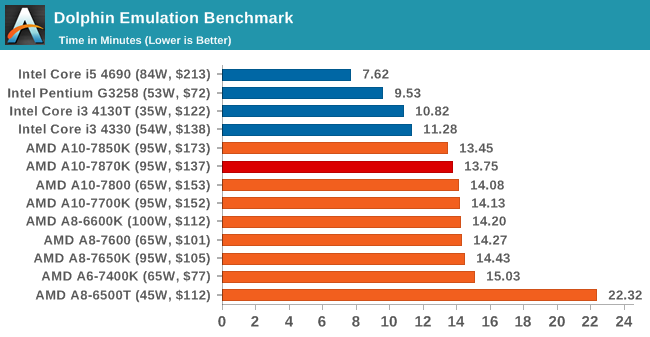
WinRAR 5.0.1: link
Our WinRAR test from 2013 is updated to the latest version of WinRAR at the start of 2014. We compress a set of 2867 files across 320 folders totaling 1.52 GB in size – 95% of these files are small typical website files, and the rest (90% of the size) are small 30 second 720p videos.
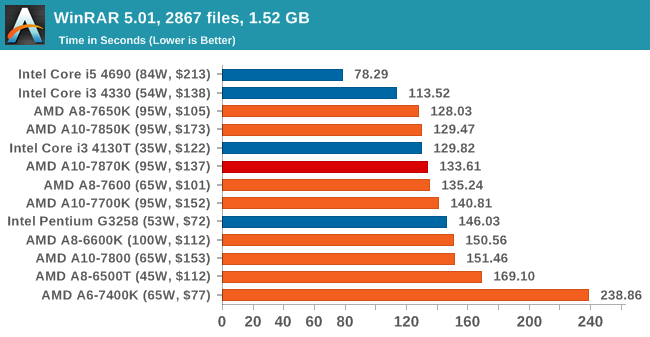
3D Particle Movement
3DPM is a self-penned benchmark, taking basic 3D movement algorithms used in Brownian Motion simulations and testing them for speed. High floating point performance, MHz and IPC wins in the single thread version, whereas the multithread version has to handle the threads and loves more cores.
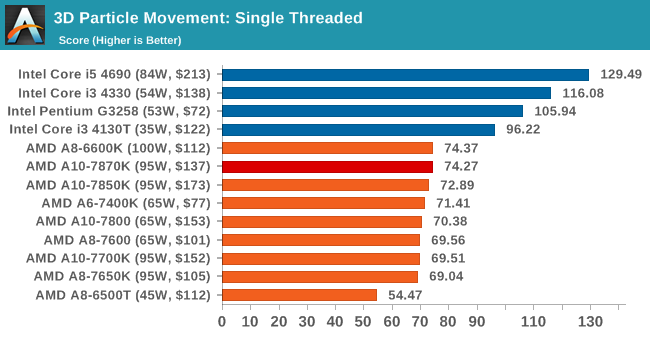
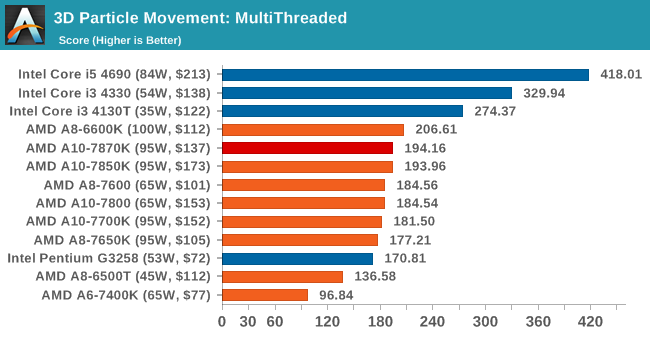
FastStone Image Viewer 4.9
FastStone is the program I use to perform quick or bulk actions on images, such as resizing, adjusting for color and cropping. In our test we take a series of 170 images in various sizes and formats and convert them all into 640x480 .gif files, maintaining the aspect ratio. FastStone does not use multithreading for this test, and results are given in seconds.
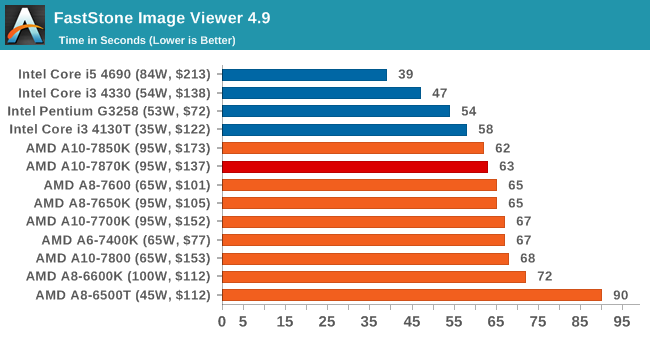
Web Benchmarks
On the lower end processors, general usability is a big factor of experience, especially as we move into the HTML5 era of web browsing. For our web benchmarks, we take four well known tests with Chrome 35 as a consistent browser.
Sunspider 1.0.2

Mozilla Kraken 1.1
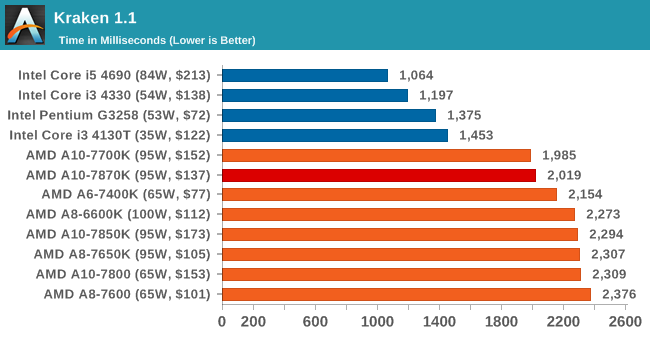
WebXPRT
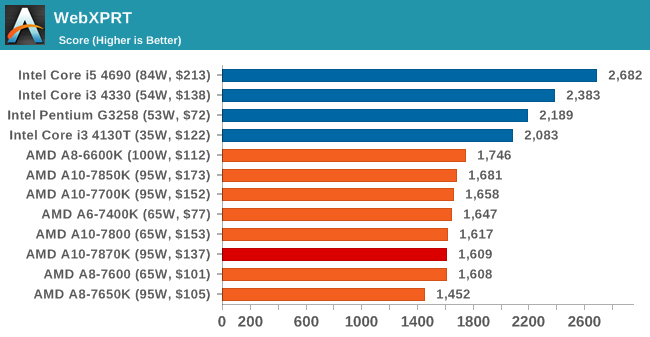
Google Octane v2
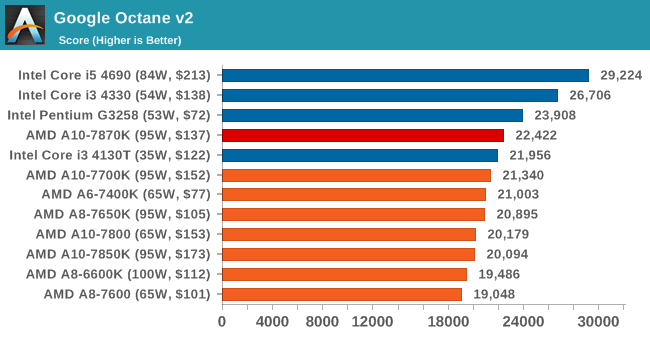










140 Comments
View All Comments
msroadkill612 - Thursday, May 23, 2019 - link
Your words are sage indeed sir. Reading them in 2019 it is clear how right you are. Of course your suggested combo is better buying for gaming performance.Cryio - Monday, June 1, 2015 - link
8320E? That's almost as expensive as the 8350.The best bang for the buck in AMD's portofolio is the 8300. Yes, you've read that right, 8300. Same TPD as the 8320E with some frequencies, same overclock capabilities and for 20% cheaper. It's only slightly more than an FX 6300.
Oxford Guy - Tuesday, June 2, 2015 - link
The 8320E is $100 from Microcenter.Cryio - Tuesday, June 2, 2015 - link
Then awesome. But generally, the 8300 is the cheapest you can buy.Dresdenboy - Monday, June 1, 2015 - link
What is the BIOS version being used? And what was the voltage?According to CPU World there might be heavy throttling with a somewhat older BIOS. The newer version fixes the problems:
"Update (May 31): Throttling problem was fixed by upgrading to P2.60 BIOS. Thanks to Roger Harshman for the hint! The processor is stable now, and runs CPU benchmarks and games without throttling and lockups. By the way, new BIOS sets lower core voltage, close to 1.45V."
Cryio - Monday, June 1, 2015 - link
The only thing that saddens me is that on average, the iGPU in the 7870K is still just 3 fps faster on average than a 240 DDR3.On paper, the iGPU should be as fast as a 7750 GDDR5 ! Not to mention the iGPU is based on GCN 1.1.
But for whatever reason, it's still 50% slower than it should be.
frozentundra123456 - Monday, June 1, 2015 - link
No, it has the same number of shaders as the 7750, but lower clocks, less bandwidth, and a limited thermal envelope. I don't know why you think it should be as fast as the 7750.Cryio - Monday, June 1, 2015 - link
Same number of shaders (both have 512), indeed lower clocks but newer architecture which should compensate for deficiencies.Plus 2400 DDR3 dual channel should allow it all the bandwidth in the world.
nikaldro - Tuesday, June 2, 2015 - link
Nope. GDDR5 is immensely better than any DDR3 on the planet, plus the APU has to throttle back due to the TDP constraints. NO WAY it will reach a 7750. the newer architecture isn't much faster, the main improvement are the added features.fallaha56 - Monday, June 1, 2015 - link
where is a DX12 preview? this is what is really needed to see which chip is the one to get...